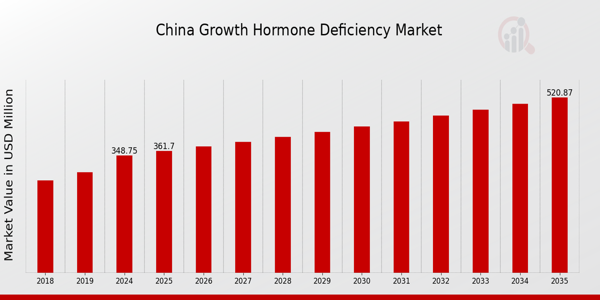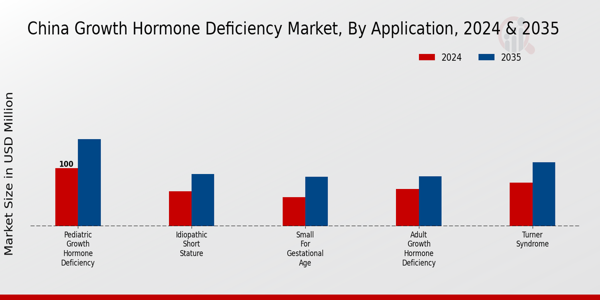China Growth Hormone Deficiency Market Overview
As per MRFR analysis, the China Growth Hormone Deficiency Market Size was estimated at 333.75 (USD Million) in 2023. The China Growth Hormone Deficiency Market Industry is expected to grow from 348.75(USD Million) in 2024 to 520.88 (USD Million) by 2035. The China Growth Hormone Deficiency Market CAGR (growth rate) is expected to be around 3.714% during the forecast period (2025 - 2035)
Key China Growth Hormone Deficiency Market Trends Highlighted
In China, the Growth Hormone Deficiency Market is experiencing significant trends shaped by rising healthcare awareness and increased diagnosis rates of growth hormone deficiencies. An important market driver is the expanding elderly population and childhood obesity, which leads to an uptick in health issues associated with growth hormone deficiencies.
The Chinese government is promoting initiatives aimed at improving healthcare access, supporting research, and encouraging the development of advanced therapies, thus driving market growth. Moreover, there is an opportunity to capture the untapped potential in both urban and rural areas, given the growing interest among healthcare professionals to diagnose and treat growth disorders.
With the involvement of both public and private sector players in enhancing innovation, companies can explore partnerships to develop targeted therapies that meet local needs more effectively. Recent trends reveal a shift towards more personalized medical approaches in growth hormone therapy, with an emphasis on understanding genetic and environmental factors that contribute to growth deficiencies. Chinese clinical guidelines are continuously being updated to reflect these advances, ensuring that treatments are both effective and tailored for individual patients.
Additionally, there is a noticeable trend toward the acceptance of biotechnology-derived therapies, as patients and practitioners alike are recognizing their benefits over traditional treatment methods.In summary, as awareness and accessibility increase, the Growth Hormone Deficiency Market in China shows strong signs of growth fueled by evolving healthcare practices and a commitment to innovation.

Source: Primary Research, Secondary Research, Market Research Future Database and Analyst Review
China Growth Hormone Deficiency Market Drivers
Increasing Awareness of Growth Hormone Deficiency in China
In China, there has been a noticeable increase in awareness of growth hormone insufficiency, mostly due to the implementation of comprehensive educational campaigns and initiatives by government agencies and healthcare organizations. The Ministry of Health, for example, has made a concerted effort to disseminate knowledge on growth abnormalities and the various therapies for ailments like Growth Hormone Deficiency (GHD). According to a recent poll, during the previous five years, healthcare professionals' awareness has grown by 40%, which has resulted in earlier diagnosis and higher treatment rates.
As parents and pediatricians become more aware of the signs of GHD in youngsters, the China Growth Hormone Deficiency Market Industry is seeing an increase in the number of new patients. This increased awareness is essential for propelling the industry since it results in more prescriptions and a treatment-friendly atmosphere.
Rising Incidence of Chronic Conditions
The prevalence of chronic conditions that can lead to GHD is escalating in China, with societal shifts and lifestyle changes contributing significantly. A report from the National Health Commission indicated that chronic diseases are a leading cause of mortality, accounting for roughly 86% of all deaths in the country.
This rising trend is expected to create a more substantial patient pool for the China Growth Hormone Deficiency Market Industry, as conditions such as obesity, diabetes, and even stress-related disorders are directly correlated with growth problems.With the country's growing aging population, which is set to reach approximately 400 million by 2035, according to government projections, the demand for growth hormone therapies and monitoring is predicted to skyrocket.
Technological Advancements in Growth Hormone Treatments
Innovations in biotechnology and pharmaceutical development are playing a crucial role in expanding the China Growth Hormone Deficiency Market Industry. Companies like Jiangsu Hengrui Medicine Co., Ltd. are increasingly investing in Research and Development to improve the formulation and delivery of growth hormone therapies. Recent advancements such as needle-free delivery systems and long-acting growth hormone preparations have the potential to reduce patient discomfort and improve adherence.The World Health Organization has noted that global investments in advanced medical technology are expected to increase, with China projected to be one of the highest spenders in health technology by 2025.
These technological improvements are poised to drive demand as they enhance treatment efficacy and patient compliance in managing GHD.
China Growth Hormone Deficiency Market Segment Insights
Growth Hormone Deficiency Market Application Insights
The China Growth Hormone Deficiency Market, particularly within the Application segment, showcases a diverse range of conditions that require careful attention and treatment strategies. The prevalence of Pediatric Growth Hormone Deficiency reflects a critical need for early diagnosis and intervention, as addressing growth issues in children can significantly impact their overall health and psychosocial development. Additionally, Turner Syndrome, which affects females and is characterized by a variety of health challenges, also plays a significant role in shaping the growth hormone therapy landscape in China.
This condition often necessitates tailored treatment plans, allowing affected individuals to attain optimal growth outcomes. Markets for Idiopathic Short Stature, characterized by children whose height is significantly lower than their peers without identifiable medical reasons, indicate an increase in awareness and diagnosis, leading to the expanded need for therapy solutions. Moreover, Small for Gestational Age represents another condition that encapsulates a growing demographic within the market, emphasizing the importance of timely medical interventions to ensure childhood growth is on an appropriate trajectory.
The Adult Growth Hormone Deficiency segment is equally crucial, as it concerns a cohort that exhibits not only physical implications such as decreased muscle mass and increased fat but also psychological effects affecting quality of life, necessitating comprehensive care strategies.Prader-Willi Syndrome, a complex genetic disorder, highlights the diversity of the Growth Hormone Deficiency Market in China, revealing a specific need for hormone treatments that can address the unique challenges posed by this condition.
The other conditions encompassed by the market also contribute to a broader understanding of growth issues that may require therapeutic intervention, each uniquely influencing the treatment landscape in the China Growth Hormone Deficiency Market.
As China continues to improve its healthcare infrastructure and increase access to care, these various applications are expected to thrive, pointing toward a positive trend in health and wellness for individuals experiencing growth deficiencies. The growth of the market appears to be supported by various factors, including rising health awareness, advancements in treatment technologies, and an aging population reflecting a heightened need for growth hormone solutions.

Source: Primary Research, Secondary Research, Market Research Future Database and Analyst Review
Growth Hormone Deficiency Market Route of Administration Insights
The Route of Administration segment in the China Growth Hormone Deficiency Market plays a crucial role in the distribution and effectiveness of growth hormone therapies. This market segment can be primarily categorized into three main modes: Subcutaneous, Intravenous, and Intramuscular. Among these, the Subcutaneous method is often preferred due to its ease of administration and comfort for patients, allowing for self-injection, which is significant for pediatric patients, prevalent in China. The Intravenous route, while less commonly employed for growth hormone treatments, is utilized in clinical settings where immediate hormone delivery is crucial, reflecting a sophisticated approach to patient care.
Meanwhile, the Intramuscular route tends to be less favorable due to discomfort and the need for trained healthcare professionals for administration. Growth hormone deficiency largely impacts the pediatric and adolescent populations in China, driving the need for efficient and user-friendly administration methods. The market trends indicate a growing preference for methods that minimize patient discomfort while maximizing therapeutic effectiveness, corresponding with government healthcare initiatives aimed at improving child health outcomes. Overall, understanding the dynamics of the Route of Administration segment is vital for fostering innovation and optimizing patient treatment strategies in the China Growth Hormone Deficiency Market.
Growth Hormone Deficiency Market Distribution Channel Insights
The Distribution Channel for the China Growth Hormone Deficiency Market plays a crucial role in ensuring that treatments reach patients efficiently and effectively. The landscape encompasses various channels, including Hospital Pharmacies, Retail Pharmacies, Online Pharmacies, and Specialty Pharmacy. Hospital Pharmacies are significant due to their direct access to healthcare professionals, providing tailored therapies to patients post-diagnosis. Retail Pharmacies are essential for easy access, facilitating consumer purchase of medications, which enhances adherence to treatment plans.
Online Pharmacies have gained traction, especially with the growing trend towards digital healthcare in China, offering convenience and broader access to medications. Specialty Pharmacies focus on complex therapies, catering to patients with specific needs, and often play a vital role in managing chronic conditions related to growth hormone deficiency. The ability of these channels to adapt to the changing market landscape is fundamental, as they help meet the increasing demand for growth hormone therapies, thereby addressing patient needs effectively.
The overall distribution network must also navigate challenges such as regulatory compliance and competition while seizing opportunities presented by an expanding patient population and advancements in digital health solutions, creating a dynamic and evolving environment in the market.
Growth Hormone Deficiency Market Brand Insights
The Brand segment within the China Growth Hormone Deficiency Market signifies a critical component of the overall industry framework, contributing uniquely to the therapeutic landscape for growth hormone deficiency management. Prominent products such as Norditropin, Genotropin, Humatrope, Saizen, and Omnitrope are recognized for their efficacy, each offering distinct formulations and delivery mechanisms that cater to diverse patient needs. These brands dominate the market due to their established reputation, clinical support, and ongoing development efforts, which enhance their reliability among healthcare providers.
Notably, the increased awareness of growth hormone deficiency and associated disorders among the Chinese population is driving demand for branded therapies. Furthermore, government initiatives aimed at improving access to healthcare and encouraging research and development in the pharmaceutical sector bolster the significance of these brands within the market. As the market evolves, newer entrants and innovations may also contribute to changing dynamics, yet established brands are likely to maintain their substantial influence due to their strong market presence and trusted performance in the treatment of growth hormone deficiency in China..
China Growth Hormone Deficiency Market Key Players and Competitive Insights
The China Growth Hormone Deficiency Market is witnessing significant evolution due to various factors such as the increasing prevalence of growth hormone deficiency, heightened awareness of health and wellness, and advances in biotechnology. The competitive landscape in this market is marked by innovative treatment options and a range of pharmaceutical players striving to establish their presence. The market is characterized by a mix of local and international companies, with distinct strategies targeting patient populations, distribution channels, and pricing models.
The competition is fierce, as firms not only seek to differentiate their products but also respond to regulatory changes and evolving healthcare dynamics within China, which plays a crucial role in shaping market trajectories and opportunities.Beijing Tide Pharmaceutical has solidified its position within the China Growth Hormone Deficiency Market through a focus on developing a diverse portfolio of growth hormone products. The company has leveraged its strong research and development capabilities and local market knowledge to create targeted therapies that address specific health needs.
The strengths of Beijing Tide Pharmaceutical lie in its robust manufacturing processes and a distribution network that ensures efficient delivery to healthcare providers and patients.
Furthermore, its commitment to enhancing patient outcomes through quality products has led to a loyal customer base, positioning the company favorably against its competitors in this niche market. This commitment to innovation and accessibility continues to underlie its strategic initiatives in the healthcare landscape of China.Merck, on the other hand, has a notable impact within the China Growth Hormone Deficiency Market by offering key products that cater to patients diagnosed with growth hormone deficiencies.
The company’s expertise in biopharmaceuticals, along with a strong emphasis on research and development, allows it to introduce advanced therapies that meet the evolving needs of the healthcare sector in China. Merck’s strengths come from its extensive market reach and solid partnerships with healthcare institutions, which facilitate access to its innovative solutions. Moreover, the company is actively involved in mergers and acquisitions to enhance its product portfolio, evidenced by strategic collaborations that expand its footprint in the Chinese market.
With a focus on cutting-edge therapies and a commitment to improving patient lives, Merck continues to maintain a strong competitive stance in the China Growth Hormone Deficiency Market.
Key Companies in the China Growth Hormone Deficiency Market Include
- Beijing Tide Pharmaceutical
- Shanghai Junshi Biosciences
- CSPC Pharmaceutical Group
China Growth Hormone Deficiency Market Industry Developments
The China Growth Hormone Deficiency Market has witnessed significant developments recently, with major companies actively engaging in Research and Development and expanding their product portfolios. In October 2023, Beijing Tide Pharmaceutical reported advancements in their growth hormone formulations, targeting improved patient outcomes in pediatric populations. Merck and Eli Lilly are also focusing on innovative treatments, reinforcing their commitment to addressing growth-related disorders in China.
Moreover, the market is experiencing notable growth in valuation, driven by increasing awareness about hormonal deficiencies and rising healthcare expenditures among the Chinese population. In terms of mergers and acquisitions, Ferring Pharmaceuticals announced a strategic partnership with Shanghai Junshi Biosciences in September 2023, aimed at enhancing its market presence. Boehringer Ingelheim and Novo Nordisk have been investing in local collaborations to voice the importance of growth hormone therapy, ensuring wider access for patients. Additionally, the competitive landscape has intensified with Pfizer's recent entry into the market with new therapies.
Significant happenings over the past two years include the regulatory approvals granted to various growth hormone biosimilars, which have expanded treatment options and brought down costs for patients in China, reflecting positively on market dynamics.
China Growth Hormone Deficiency Market Segmentation Insights
-
Growth Hormone Deficiency Market Application Outlook
- Pediatric Growth Hormone Deficiency
- Small for Gestational Age
- Adult Growth Hormone Deficiency
-
Growth Hormone Deficiency Market Route of Administration Outlook
-
Growth Hormone Deficiency Market Distribution Channel Outlook
-
Growth Hormone Deficiency Market Brand Outlook
| Report Attribute/Metric Source: |
Details |
| MARKET SIZE 2023 |
333.75(USD Million) |
| MARKET SIZE 2024 |
348.75(USD Million) |
| MARKET SIZE 2035 |
520.88(USD Million) |
| COMPOUND ANNUAL GROWTH RATE (CAGR) |
3.714% (2025 - 2035) |
| REPORT COVERAGE |
Revenue Forecast, Competitive Landscape, Growth Factors, and Trends |
| BASE YEAR |
2024 |
| MARKET FORECAST PERIOD |
2025 - 2035 |
| HISTORICAL DATA |
2019 - 2024 |
| MARKET FORECAST UNITS |
USD Million |
| KEY COMPANIES PROFILED |
Beijing Tide Pharmaceutical, Merck, Eli Lilly, Sandoz, Ferring Pharmaceuticals, Boehringer Ingelheim, Novo Nordisk, Shanghai Junshi Biosciences, Pfizer, Ipsen, Amgen, Hepalink, Genetech, CSPC Pharmaceutical Group |
| SEGMENTS COVERED |
Application, Route of Administration, Distribution Channel, Brand |
| KEY MARKET OPPORTUNITIES |
Increased awareness of GHD, Rising prevalence of obesity, Expansion of pediatric treatments, Advancements in biotech solutions, Growing number of healthcare facilities |
| KEY MARKET DYNAMICS |
increasing prevalence of GHD, rising awareness and diagnosis, advancements in treatment options, government healthcare initiatives, growing market players and competition |
| COUNTRIES COVERED |
China |
Frequently Asked Questions (FAQ):
The expected market size for the China Growth Hormone Deficiency Market in 2024 is approximately 348.75 million USD.
The market is expected to grow at a CAGR of 3.714% from 2025 to 2035.
By 2035, the overall market is projected to be valued at around 520.88 million USD.
Pediatric Growth Hormone Deficiency is expected to be valued at 100 million USD in 2024.
The projected market size for Turner Syndrome by 2035 is approximately 110 million USD.
Major players include Beijing Tide Pharmaceutical, Merck, Eli Lilly, and Novo Nordisk among others.
The expected market size for Adult Growth Hormone Deficiency in 2024 is around 63.75 million USD.
By 2035, the market segment for Idiopathic Short Stature is projected to grow to approximately 90 million USD.
Opportunities include emerging treatments and increased awareness of growth hormone deficiencies.
Key challenges include high treatment costs and the need for effective patient management strategies.
















